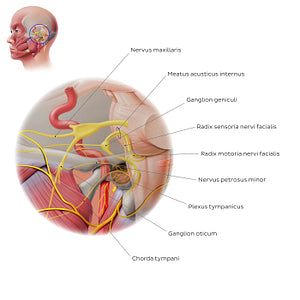Paul Kim
Facial nerve: intracranial/intratemporal parts (Latin)
Facial nerve: intracranial/intratemporal parts (Latin)
The larger and more medial radix motoria as well as the smaller, more lateral, radix sensoria (n. intermedius) arise at the angulus pontocerebellaris and traverse the fossa posterior cranii, forming the pars intracranialis nervi facialis. The roots then enter the os temporale via the meatus acusticus internus together with the n. vestibulocochlearis, as well as the a./v. labyrinthi. The radices sensoria/motoria usually merge at, or within the meatus acusticus internus, and then continue into the canalis facialis located along the medial wall of the cavitas tympani. Here, the n. facialis expands into the ganglion geniculi, which contains the cell bodies of the sensory neurons related to the nerve. The n. petrosus major arises directly from the ggl. geniculi and carries general visceral efferent (parasympathetic) fibers destined for the gl. lacrimalis, gll. nasales et palatinae, as well as special visceral afferent (taste) fibers from the palate (both via the ggl. pterygopalatinum). The n. facial then gives off two further intratemporal branches (nervus stapedius and chorda tympani) which arise before the facial nerve exits the temporal bone via the foramen stylomastoideum. The chorda tympani carries both parasympathetic fibers destined for the gl. submandibularis/sublingualis as well as special visceral afferent (taste) fibers from the anterior two-thirds of the tongue via the n. lingualis (see next image).
Regular price
$7.56 USD
Regular price
Sale price
$7.56 USD
Unit price
per
Couldn't load pickup availability


#F7D725
#A15959
#662520
#4D3028
#E1CBA3
#D5B6A9

